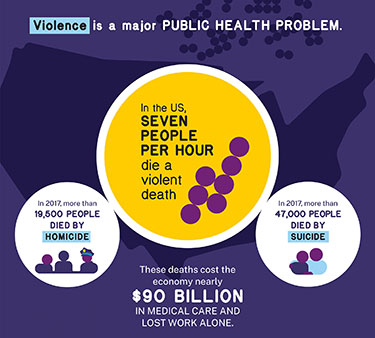Katherine Fowler, PhD, is senior scientist on the Mortality Surveillance Team in the National Center for Injury Prevention and Control’s Division of Violence Prevention. Fowler provides leadership and guidance on the National Violent Death Reporting System, which offers researchers extensive data on U.S. violent deaths.
In 2002, the Centers for Disease Control and Prevention launched NVDRS by collecting data in six states and setting up an online resource site. Today, data is collected in every state, Puerto Rico and the District of Columbia. All types of violent deaths are covered, including homicide, suicide and unintentional firearm-related deaths. Researchers are using the data to understand the context of U.S. homicides and other violent deaths, and developing preventive strategies. The June issue of The Nation’s Health includes a special section on NVDRS and how researchers can use the system.
What distinguishes NVDRS from other sources of information on U.S. deaths?
Other data systems that track violent deaths primarily count deaths and provide basic demographic information about people who have died. The strength of NVDRS is detail.
NVDRS gathers and links detailed investigative information from several sources, including law enforcement, medical examiners and coroners, toxicology, and death certificates. With this linked information, NVDRS is able to provide a much more complete picture of the circumstances that may contribute to violent deaths. It also helps identify emerging issues by collecting extended demographic information on victims and suspects, injury characteristics, and circumstances.
NVDRS data increase our knowledge about where violent deaths occur, who is most at risk and the factors that contribute to violent deaths.
How does NVDRS help in violence prevention?
These data provide the foundation for building successful strategies for preventing violence so that all communities can be safe and free from violence and people can live to their full potential.
CDC is taking steps to ensure that NVDRS data inform violence prevention activities by raising awareness about the data and promoting its use at the national level. CDC also provides resources to states to monitor and report their data, and enhance the reporting platform to increase efficiency, timeliness of data entry and consistency.
Is CDC tracking violence as it relates to COVID-19 deaths?
We have modified an existing NVDRS variable called ‘disaster exposure’ to include COVID-19-related deaths in NVDRS. This will help us quickly key into NVDRS cases related to the ongoing pandemic when the data is ready to analyze. Data for 2020 will not be available until summer or fall 2022.
The 2017 NVDRS Surveillance Summary Report, containing the most recent data, shows high violent deaths among people of color. What does the data show about why this is happening?
Racial and ethnic minorities are disproportionately exposed to systemic inequities such as residential segregation, concentrated disadvantage, stress from experiencing racism, limited access to the best educational and employment opportunities and other conditions that increase the risk for experiencing violence. Racial and ethnic minority youths often live in communities with concentrated poverty, stressed economies, residential instability and neighborhood disorganization, and low community cohesion and informal controls. All these conditions are associated with violence and violence-related injuries.
Prevention efforts will achieve greater population-level decreases in violence through the reduction and elimination of systemic inequities and by targeting salient neighborhood and community-level contributors to violence. CDC’s youth violence prevention technical package outlines several community- and societal-level programs and approaches.
Several years ago, CDC published a study on lethal force among law enforcement using NVDRS data. Given that police violence toward Black Americans has gained greater prominence and calls for action, does CDC have plans for a follow-up?
We are planning to revisit this important topic later this year with an updated analysis similar to the piece. We will again look at increases or decreases in trends, characteristics of decedents and officers involved in the incident, as well as other attributes of legal intervention deaths that will provide helpful information for prevention.
Infographic excerpt courtesy CDC.